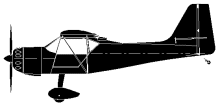
ASN Wikibase Occurrence # 296724
This information is added by users of ASN. Neither ASN nor the Flight Safety Foundation are responsible for the completeness or correctness of this information.
If you feel this information is incomplete or incorrect, you can submit corrected information.
| Date: | Sunday 25 August 2002 |
| Time: | 20:09 LT |
| Type: |  Anderson Kitfox Series 5 |
| Owner/operator: | |
| Registration: | N743JT |
| MSN: | S9501-0091 |
| Total airframe hrs: | 428 hours |
| Engine model: | Subaru EA-81 |
| Fatalities: | Fatalities: 0 / Occupants: 1 |
| Aircraft damage: | Substantial |
| Category: | Accident |
| Location: | Garden Prairie, Illinois -
 United States of America United States of America
|
| Phase: | Unknown |
| Nature: | Private |
| Departure airport: | Pellston Regional Airport, MI (PLN/KPLN) |
| Poplar Grove, IL (C77) | |
| Investigating agency: | NTSB |
| Confidence Rating: |
The aircraft collided with transmission wires during a forced landing following a complete loss of engine power. The power loss occured 7 miles from the intended destination. En route, approximately 150 nm from the destination, the pilot reported that his "fuel site gauges indicated 1/2 tank in right wing and just under 1/2 tank in left" wing. Based on this, he calculated remaining fuel at about 11 gallons, which he determined was sufficient to complete remainder of the flight. The pilot notes in his statement, that he began a slow descent, in preparation to enter the traffic pattern. According to the pilot: "With 7 NM showing on the GPS, ... and while passing 2,000 [feet] MSL the engine stopped." He reported that he attempted a restart, "but soon felt the controls get mushy," and decided to focus his attention on a setting up for a forced landing. He reported that the aircraft was "topped off" with 22 gallons of fuel prior to departure. The previous flight lasted 3.6 hours, with a fuel burn of 6.1 gallons per hour (gph), as calculated by the pilot. The accident flight was 3.8 hours. Based on information from the kit manufacturer, the fuel tank configuration installed in the accident aircraft consisted of two 13 gallon wing tanks and a header tank. The wing tanks had an unusable fuel quantity of about 2-1/2 gallons per tank -- 5 gallons total -- when in a descent (nose down attitude). In this configuration, the "fuel tends to run forward, away from the tank outlet, and during those periods fuel will be provided by the engine from the supply in the header tank," according to a service letter issued by the kit manufacturer. The pilot reported the capacity of the header was 3/4 gallon. After a flight of 3.8 hours, at a fuel burn rate of 6.1 gph, approximately 2.8 gallons remained in the wing tanks. The endurance of the 3/4 gallon header tank was approximately 7 minutes, at 6.1 gph. At a ground speed of 120 knots, this equates to about 14 miles. The pilot reported that his descent began 20 miles from the airport, and the engine quit 7 miles from the airport.
Probable Cause: The pilot's miscalculation of fuel consumption and his operation of the fuel system beyond its limitation, which resulted in fuel exhaustion. Contributing factors were transmission wires and dark night conditions.
Accident investigation:
 |
|
Sources:
NTSB CHI02LA260
Revision history:
| Date/time | Contributor | Updates |
|---|---|---|
| 14-Oct-2022 10:02 | ASN Update Bot | Added |
Corrections or additions? ... Edit this accident description
The Aviation Safety Network is an exclusive service provided by:


 ©2024 Flight Safety Foundation
©2024 Flight Safety Foundation